Hickory Nut GorgeState Trail Plan




of Parks and








The vision for the Hickory Nut Gorge State Trail (HGST) encompasses three main purposes: conservation, recreation, and connection.
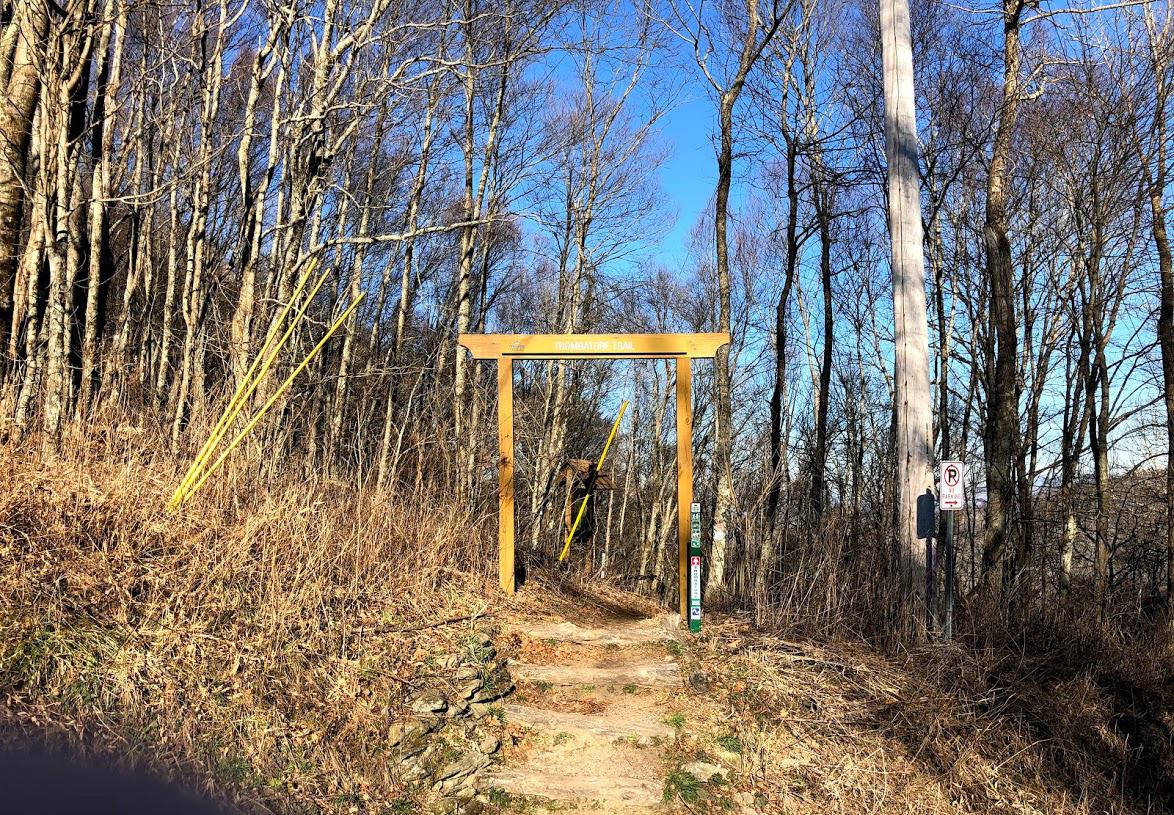
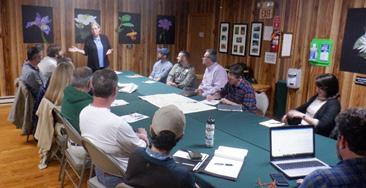
The trail corridor will serve as an ecological connection between larger tracts of natural lands protecting wildlife migration and safeguarding the genetic variability of plant and wildlife populations. Encouraging segment sponsors to remove invasive, nonnative species during routine trail maintenance will further increase the conservation value of this trail. In this way, the Hickory Nut Gorge State Trail is part of a statewide conservation effort to ensure the future health and beauty of North Carolina’s natural resources.
At least 50 miles of trail through some of North Carolina’s most scenic landscapes will provide an amazing recreational amenity for hikers and mountain bicyclists. The trail will provide safe and enjoyable recreation and exercise opportunities. This will offer local citizens with a convenient and stunning venue to improve their health with more physical activity and serve to attract visitors throughout the larger region, boosting tourism to the entire area.
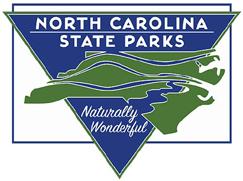
Finally, the Hickory Nut Gorge State Trail will provide a connection between Chimney Rock State Park; Lake Lure; Upper Hickory Nut Gorge including Bearwallow Mountain, Florence Nature Preserve, and Wildcat Rock; and Buffalo Creek Park. Local citizens, visitors, and even wildlife, will be able to use this connection to access natural lands while protected from vehicular traffic.
Stakeholder meetings were held.
The legislation that created the Hickory Nut Gorge State Trail states: The General Assembly authorizes the Department of Natural and Cultural Resources to add the Hickory Nut Gorge trail to the State Parks System as a State trail, as provided in G.S. 143B-135.54(b). The Department shall support, promote, encourage, and facilitate the establishment of trail segments on State park land and on lands of other federal, State, local and private landowners. On segments of the Hickory Nut Gorge trail that cross property controlled by agencies or owners other than the Department’s Division of Parks and Recreation, the laws, rules, and policies of those agencies or owners shall govern the use of the property. The requirement of G.S. 143B-135.54(b) that additions be accompanied by adequate appropriations for land acquisition, development, and operations shall not apply to the authorization set forth in this section. For purposes of this section, the “Hickory Nut Gorge trail” refers to the trail through the Hickory Nut Gorge located within Henderson, Rutherford, and Buncombe counties, and encompasses current and future permanently publicly accessible recreational trails inside, or within 5 miles of, the physical boundaries of the Hickory Nut Gorge, Lake Lure, Broad River, or Chimney Rock State Park.
The Hickory Nut Gorge State Trail will connect with the Wilderness Gateway Trail near Buffalo Creek Park, and will meander through Rutherford, Henderson, and Buncombe Counties to connect to Chimney Rock State Park, Conserving Carolina’s Upper Hickory Nut Gorge trails, and Town of Lake Lure’s Buffalo Creek Park.

This proposed corridor will traverse through the Hickory Nut Gorge located within Henderson, Rutherford, and Buncombe counties.
Henderson County was formed in 1883 from the southern part of Buncombe county and named after Leonard Henderson, the Chief Justice the NC Supreme court from 1829 to 1833. The county seat is Hendersonville. The county is 375 square miles and is in the Blue Ridge Mountains. In 2018, the population was estimated to be 116,748.
Rutherford County was formed in 1779 and named after the Revolutionary War general and member of the North Carolina Provincial Congress, Griffith Rutherford. The county seat is Rutherfordton. The economy of Rutherford County includes tourism, Christmas trees, and textiles. The county is 564 square miles and is in the Broad River basin. In 2016 the population was estimated to be 66,421.
Town of Lake Lure is a well-known destination due to its beautiful location in the heart of the Hickory Nut Gorge, with the Rocky Broad River winding through the valley into Lake Lure. The town is 14.7 square miles and has a population of about 1,214 individuals according to the 2016 census, but this greatly increases during high tourism seasons.
Buncombe County was formed in 1791 from parks of Burke and Rutherford County and named after Edward Buncombe, a colonel in the American Revolutionary war who was captured at the Battle of Germantown. The county consists of 660 square miles, with the French Broad River flowing through portions. In 2019, the population was estimated to be 259,103.

Chimney Rock State Park features some of North Carolina’s most dramatic mountain scenery with the signature 315-foot spire overlooking Hickory Nut Gorge and Lake Lure within its 5,700 acres. NC State parks acquired Chimney Rock in 2007, but the park has a rich history starting in 1871, when tourists began making their way up to the top by donkey.
Weed Patch Mountain Trail is within Buffalo Creek Park and consists of 8.6 miles of strenuous trail in backcountry terrain. The trail is designed for hikers and mountain bikers and offers access to Eagle Rock within Chimney Rock State Park, which is a popular climbing destination.
The southernmost section of the Hickory Nut Gorge State Trail will connect with Chimney Rock State Park.
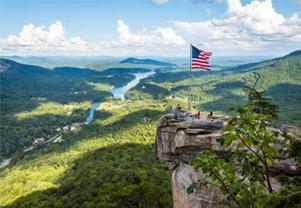

The Town of Lake Lure.
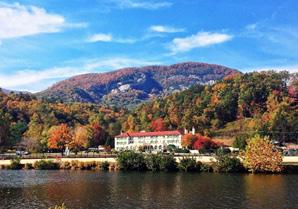

Division staff met with stakeholders and volunteers to explain the concept, learn about current plans and constructed trail that could be incorporated into the HGST, and listen to suggestions, concerns and priorities. Stakeholders included: Town of Lake Lure, Rumbling Bald Resort, Chimney Rock State Park, Conserving Carolina, Rutherford County, Henderson County, Carolina Climbers Coalition, Friends of Chimney Rock, Rutherford Outdoor Coalition, and Isothermal Planning and Development Commission. A crew of volunteer trail builders with Conserving Carolina was also able to participate in the stakeholder meetings.
Shortly after the stakeholder meetings, COVID-19 prevented any further in person meetings. So, the public information sessions and surveys were accomplished online. 508 people participated in the online survey and 1,278 viewed the online information session—an unexpectedly robust number for a trails master plan. With stakeholders, volunteers and the public response, there was near universal support for the HGST. Additionally, the comments indicated support for a disc golf course to be incorporated into the trail and strong support for the trail to serve as access to additional climbing areas. However, both activities are beyond the scope of a state trail master plan—or a constructed state trail. Nevertheless, these comments will be shared with the stakeholders so that they can consider them in future planning efforts. The results from the public survey can be found in Appendix 1.
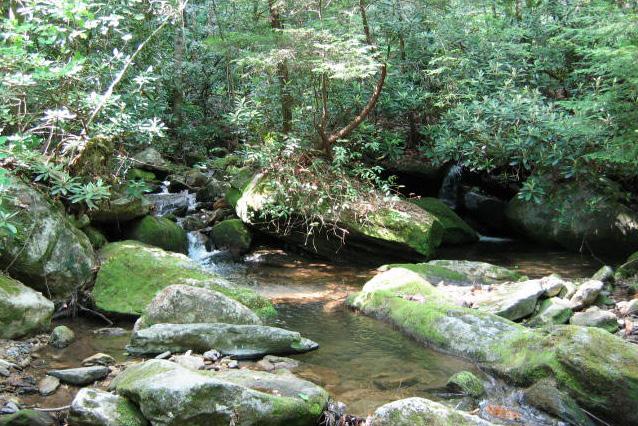




Description:
A series of connected trails, planned and constructed by Conserving Carolina, that encircle Bearwallow Mountain.

Planning Strategies:
Support Conserving Carolina as they work to complete gaps.
Projected Timeframe: near-term
Opportunities:
• Public support • Local planning • Large landholdings
Funding Stream/river corridors • Land conservancy support
• Land acquisition Floodplain/wetlands Private support
Public land Staff resources Sidewalk/bicycle network
Challenges:
Funding Major roadway crossing Lack of local planning
Land acquisition Coordinating easements Floodplain/wetlands
Stream/river crossings Urbanized corridor Local opposition
Needs detailed alignment • Topography Long-term management
Segment Details:
Constructed trail:
Trombatore Trail: 2.4 miles
Wildcat Rock Trail: 5 miles
Route thru Florence Nature Preserve: 1.8 miles
Bearwallow Mountain Trail: 1 mile
Total: 10.2 miles
Route alignment: Trail will circle Bearwallow Mountain on conserved land and through permanent easements.
Approximate planned length: 15 miles
Section sponsors: Conserving Carolina
Planning stakeholders: Conserving Carolina, Henderson County, Buncombe County, NC State Parks
Next Steps:
• Determine trail route through Florence Nature Preserve
• Encourage Conserving Carolina to apply for official trail designation for all segments of constructed trail

• Complete Strawberry Gap Trail
• Plan connection between Florence Nature Preserve and Strawberry Gap Trail
• Land acquisition

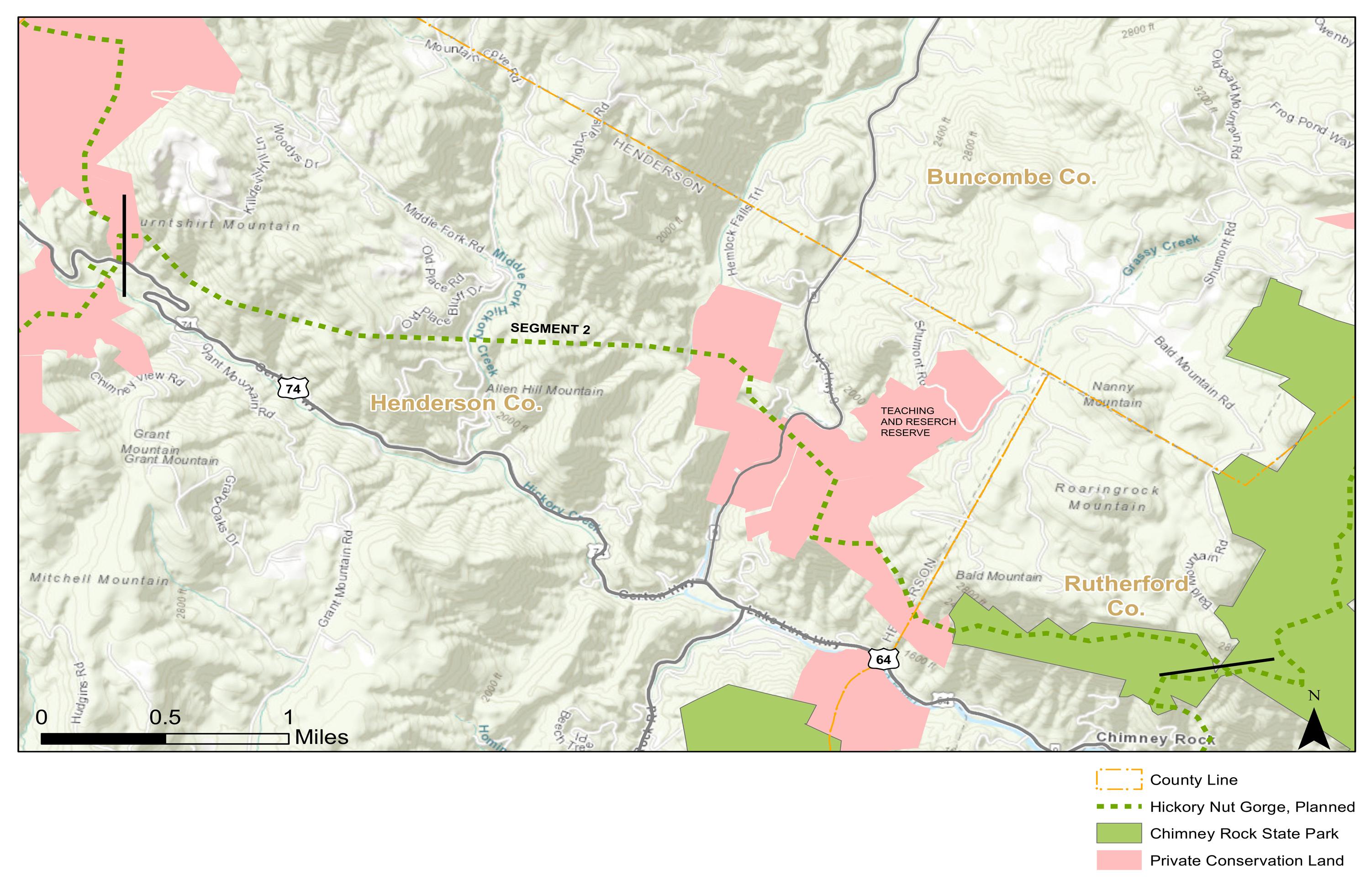
Description:
This segment will connect the loop around Bearwallow Mountain to Lake Lure Loop.
Planning Strategies:
Corridor will need to be protected through land acquisition or permanent easements. Conserving Carolina, with support from NC State Parks, could take lead on land protection. Must coordinate final route with the Nature Conservancy to avoid disturbing bats protected near Bat Cave.
Projected Timeframe: long-term
Opportunities:
• Public support Local planning Large landholdings
Funding Stream/river corridors • Land conservancy support
Land acquisition Floodplain/wetlands Private support
Public land Staff resources Sidewalk/bicycle network
Challenges:
• Funding • Major roadway crossing • Lack of local planning
• Land acquisition • Coordinating easements Floodplain/wetlands
Stream/river crossings Urbanized corridor Local opposition
• Needs detailed alignment • Topography • Long-term management

Segment Details:
Constructed trail: 0 miles
Route alignment: Although dependent on land acquisition, route will probably be north of US 74 ALT.
Approximate planned length: 5 miles
Section sponsors: TBD
Planning stakeholders: Conserving Carolina, NC State Parks, Nature Conservancy, Bat Cave

Next Steps:
• Detailed corridor planning to identify best route for trail
• Funding for land acquisition
Parks


Description:
This segment will circle Lake Lure. Much of the trail will be around the perimeter of Chimney Rock State Park. Weed Patch Mountain Trail, a national award-winning trail, will be included in this segment. Buffalo Creek Park, Dittmer Watts Park and Chimney Rock State Park will be connected by this segment.
Roughly 60% of this segment is on public lands—Buffalo Creek Park and Chimney Rock State Park. The trail can be designed and constructed on these lands. On the eastern side of this segment, detailed corridor planning is required before land can be protected for the trail route.

Opportunities:
• Public support • Local planning Large landholdings
Funding Stream/river corridors • Land conservancy support
Land acquisition Floodplain/wetlands Private support
• Public land • Staff resources Sidewalk/bicycle network
Challenges:
• Funding Major roadway crossing Lack of local planning
• Land acquisition Coordinating easements Floodplain/wetlands
• Stream/river crossings Urbanized corridor Local opposition
• Needs detailed alignment • Topography • Long-term management
Constructed trail:
Weed Patch Mountain Trail: 8.6 miles
Buffalo Creek Park Loop: 3.5 miles
Youngs Mountain Trail: 2.1 miles
Total: 14.2 miles
Route alignment: The route will be co-located with Weed Patch Mountain and Young’s Mountain Trails and on the perimeter of Chimney Rock State Park. The eastern portion will be dependent on land acquisition and easements.
Approximate planned length: 30 miles
Section sponsors: NC State Parks, Town of Lake Lure, Conserving Carolina, Rutherford Outdoor Coalition, and Rutherford County

Planning stakeholders: Conserving Carolina, State Parks, Lake Lure, Rutherford County
• Extend Youngs Mountain Trail to provide better public access and parking
• Design and construct trail on Chimney Rock State Park
• Consider and plan trailhead at World’s Edge
• Develop land acquisition plan for eastern side of loop
1. The Hickory Nut Gorge State Trail provides significant natural, cultural, scenic, and recreational value.
2. There is widespread support for the Hickory Nut Gorge State Trail, from both stakeholders and the public.
• Responses to our stakeholder meetings and online public information session were universally positive.
• Conserving Carolina has already developed an impressive corps of volunteer trail builders and maintainers.
• Conserving Carolina, Town of Lake Lure, and North Carolina State Parks will be some of the major segment sponsors on the HGST.

3. Much of the HGST is in challenging topography.
• Sustainable trail design and construction techniques will be vital on this trail to avoid environmental impact and unsafe conditions for trail users.
• Trailhead signage needs to be clear in detailing the difficulty of the trail so that users will be prepared.
• Trail design will be dependent on the proposed user group(S) as determined by the segment sponsor.
• There is widespread support for the trail to have sections for mountain biking and other sections reserved for only hiking.
• Fortunately, there is minimal and surmountable incompatible features such as roads, intrusive developments, or large water bodies.
o Crossing Hwy 74 in Segment 1 will be the major challenge
o The potential to use the bridge on Buffalo Shoals Rd over the Broad River warrants further investigation
4. Completing the trail to connect the loop around Bearwallow Mountain and the loop around Lake Lure will be the most challenging because of the lack of public land.
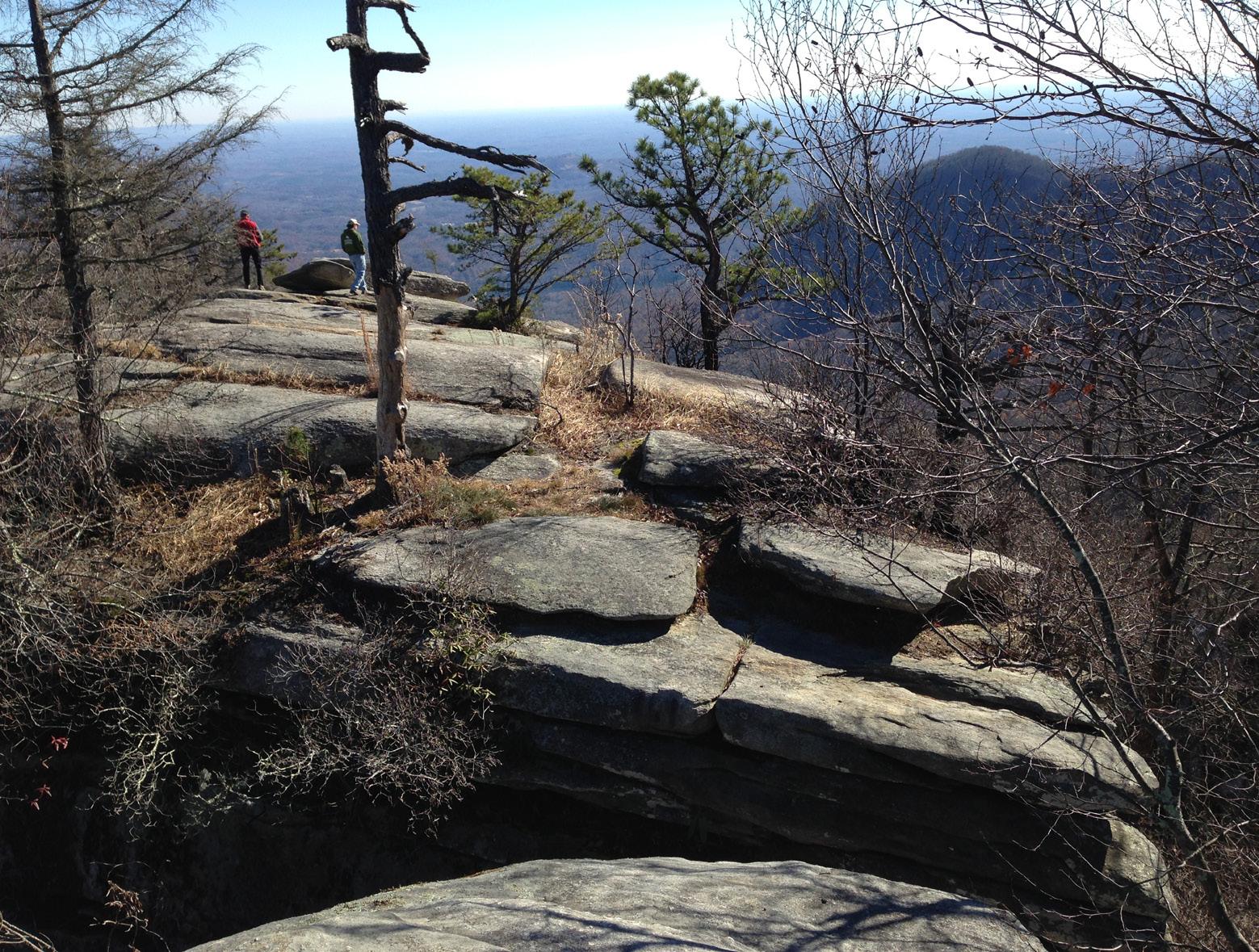
• Further planning is needed to refine where the trail will be in Segment 2.

• Ideally, local partners will reach out to private landowners to seek permanent easements for the trail corridor.

• The eastern side of the loop around Lake Lure will pose the same challenges.
5. With their history of commitment to and investment in the HGST, Conserving Carolina should serve as the primary support organization for the HGST.
1. Chimney Rock State Park Segment: The North Carolina State Parks Trails Program should develop the design for the trail segment through Chimney Rock State Park, when funding for construction is identified.
2. Access Across Broad River: North Carolina State Parks needs to partner with NCDOT to investigate the potential of providing bicycle and pedestrian accommodation on Buffalo Shoals Road as well as Highway 9 across the Broad River.
3. Species Protection: Special care needs to be taken to not disturb vulnerable animal and plant species when locating the trail in Segment 2.
4. Permanent Trail Easements: Conserving Carolinas and other local partners should begin landowner outreach to obtain permanent trail easements for the trail corridor in Segments 2 and 3.

The Division will develop a branding package for the HGST. This will include logos, blaze design and placement, and best practices for sign placement.
1. Additional Funding: Additional funding to supplement federal funding would facilitate and expedite completion of the Hickory Nut Gorge State Trail. The NC Trails Program received twice as many applications for trail funding as the Recreational Trails Program grant was able to fund.
2. Land Acquisition: Funding for land acquisition and trail easements from willing sellers will be essential to complete the trail
3. Trail Construction: Once the land or corridor is acquired, segment sponsors will need funding to design and construct the trail to sustainable standards.
4. Ongoing Maintenance and Management: Ongoing maintenance and management of the trail will be critical to its long-term success.
A State Trail authorization by the NC General Assembly is very broad in scope. Initial corridor planning and then trail design determine exactly where the trail will be located. However, constructed trail is not part of the State Trail until it is designated by the Secretary of Natural and Cultural Resources. The segment sponsor must apply to NC State Parks for the designation once the trail segment is completely constructed. Criteria for designation include public access, a viable emergency management plan, detailing facilities available to the public, and inspection by a regional trails specialist or state trails planner. Once a trail has been designated, it can then post the state trail signage.

Division of Parks
Recreation


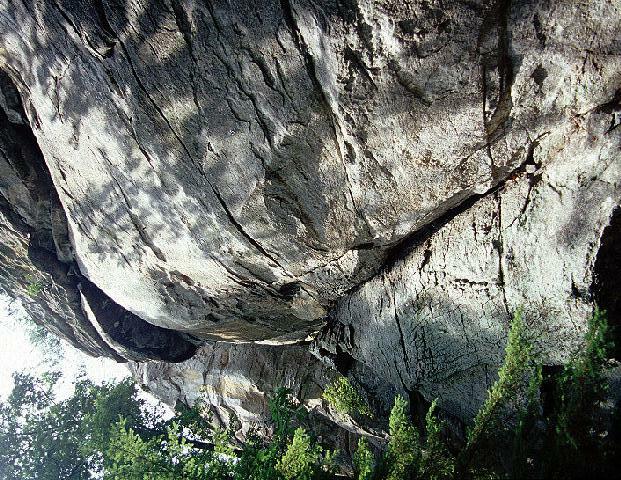


Q9. Do you have any other comments that you would like to share about the Hickory Nut Gorge State Trail?
This is not an exhaustive list of all recommendations, but the most prevalent. All suggestions will be considered.
Parks
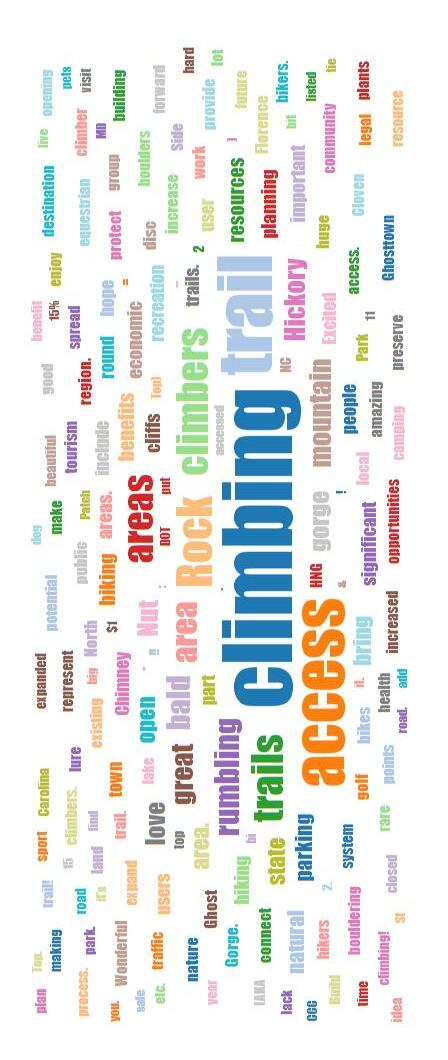

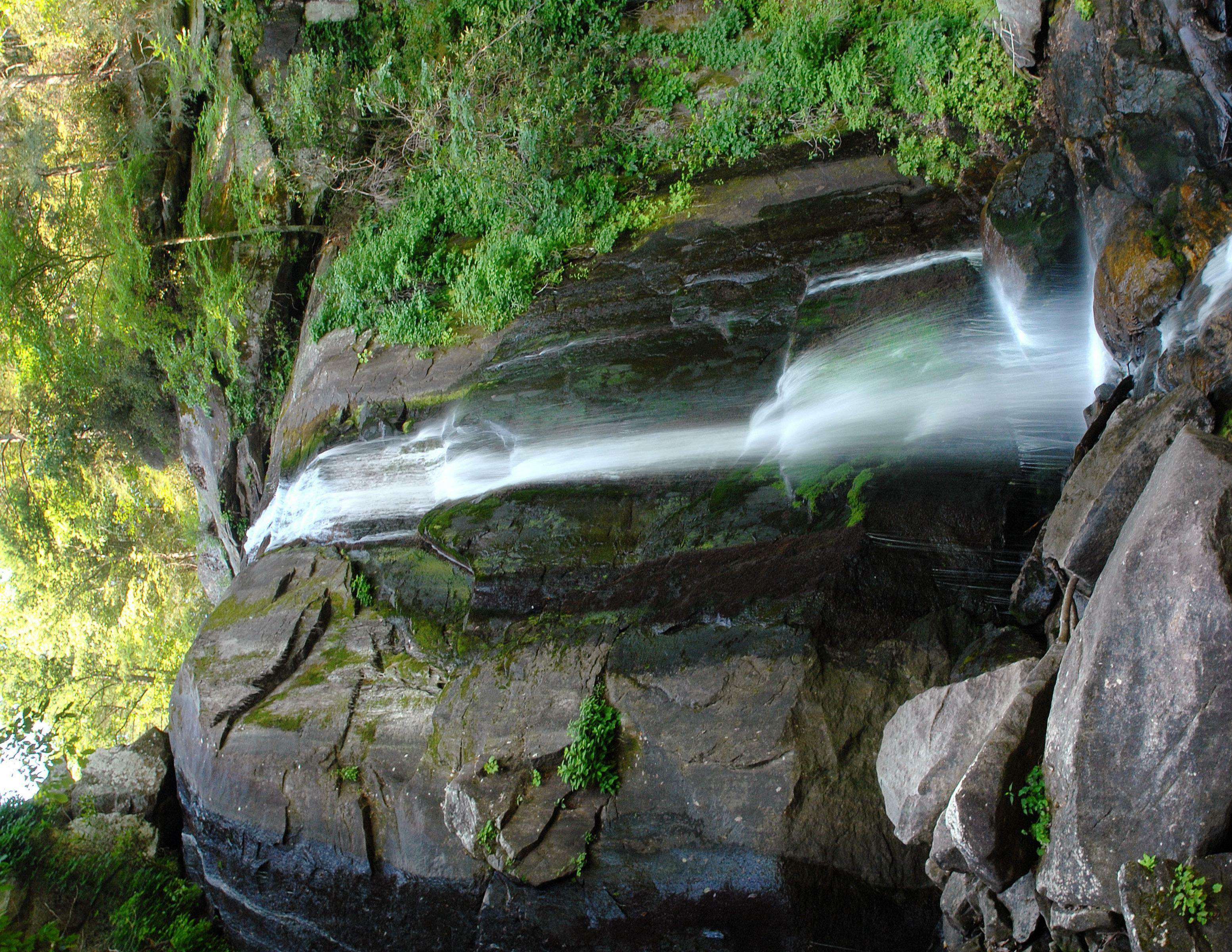
A new state trail is authorized by the General Assembly—ideally after a feasibility analysis. This analysis includes: 1. Statewide significant natural, cultural, scenic and recreation value 2. Enough potential length and beauty to attract varied and significant use from regions outside the local area. 3. Minimal and surmountable incompatible features such as roads, intrusive development or large water bodies. If a potential State Trail meets these basic requirements, then the feasibility of inclusion as a State Trail is based on: 1. Local public support for the general concept of a public trail and the availability of trail volunteers 2. Presence of viable section sponsors committed to the design, construction, maintenance and management of the trail.
3. Environmental and economic sustainability of the trail route. The law that creates a state trail may place some restrictions on the trail, such as specific counties where it must be located, but gives few other details on the trail location. To move beyond this concept, detailed planning is required. NC State Parks plans the general corridor where the trail will be located. The planning process includes meeting with stakeholders, potential segment sponsors and holding public informational meetings. Usually, the planned corridor is 5-10 miles wide to permit for segment sponsors to take advantage of available land and advantageous topography. Segment sponsors design and construct trail within the NC State Parks planned trail corridor. This should be done in coordination with NC State Parks to ensure that the segments will connect; sustainable standards are met so that the segment can be authorized as an official part of the state trail; and resources can be leveraged.
After the trail is constructed, the segment sponsor applies for state trail designation through NC State Parks. This process involves the approvals of the State Trails Planner, North Carolina Trails Committee and the Secretary of the Department of Natural and Cultural Resources. Criteria for designation include public access, an emergency management plan, detailing available amenities and inspection by a regional trails specialist.
Please contact the state trails program if you have any questions about state trails. Scott Crocker State Trails Program Manager scott.crocker@ncparks.gov
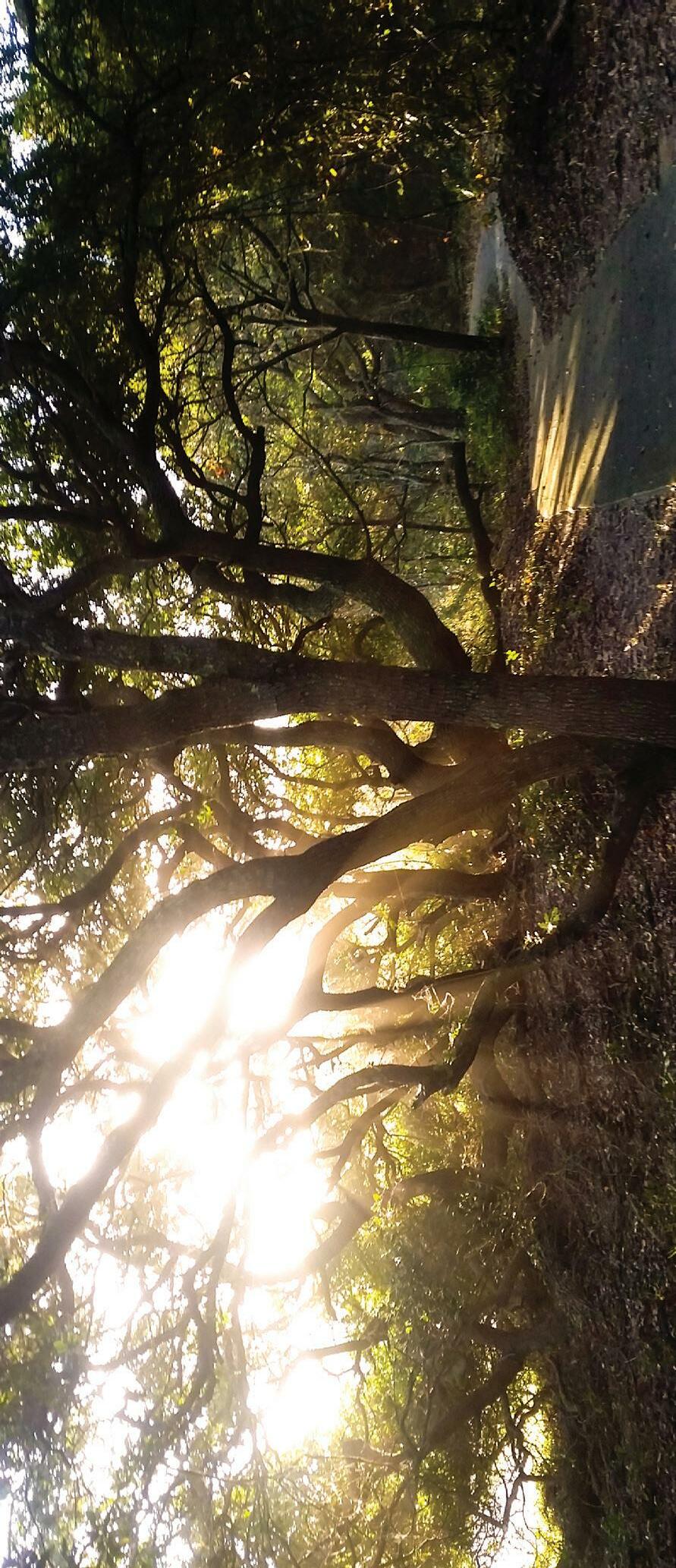 Smith Raynor State Trails Planner smith.raynor@ncparks.gov
Smith Raynor State Trails Planner smith.raynor@ncparks.gov
A State Trail is a linear corridor on land or water, protected from vehicular traffic, providing public access for non-motorized recreation or transportation. All State Trails must be authorized by the General Assembly.
Currently, there are nine State Trails in North Carolina:
■ Deep River State Trail from Jamestown to Moncure
■ Fonta Flora State Trail which circles Lake James in Burke and McDowell Counties and extends west to Asheville
■ French Broad River State Trail in Transylvania, Henderson, Buncombe and Madison Counties
■ Hickory Nut Gorge State Trail in Henderson, Rutherford, and Buncombe Counties.
■ Mountains-to-Sea State Trail stretching from Clingman’s Dome to Jockey’s Ridge State Park
■ Northern Peaks State Trail will connect Boone to West Jefferson along a series of mountain peaks, including Elk Knob State Park and Mount Jefferson State Natural Area.
■ Overmountain Victory State Trail traces the route used by patriot militia in North Carolina during the Kings Mtn campaign of 1780.
■ Wilderness Gateway State Trail connects the Hickory Nut Gorge State Trail to South Mtns State Park, Valdese and Hickory.
■ Yadkin River State Trail in Wilkes, Surry, Yadkin, Forsyth, Davidson, Rowan and Davie Counties
These trails share legal status as components of the State Parks System. This distinguishes them from other regional and local trails and pathways. These trails offer opportunities for regional connectivity and public access to some of North Carolina’s most significant and scenic landscapes.
State Trails epitomize partnerships. While a State Park is operated and managed by the Division of Parks and Recreation, a State Trail is comprised of multiple connected sections and each section of the trail is sponsored by a state or federal agency, local government or private landowner.
Section sponsors build, maintain and manage their section of the trail. This includes location, design, surface, permitted uses and amenities. Section sponsors retain authority on lands under their jurisdiction. They are encouraged to showcase places of natural, scenic, historic and cultural significance; to feature the diversity of the natural communities and landscapes in the state; to consider the needs of both long and short distance hikers; and to employ recognized standards of sustainable trail design and construction. Often, and ideally, section sponsors are supported by dedicated volunteers.
The overall trail corridor planning and coordination are the responsibility of the Division of Parks and Recreation. The Division will provide guidance, coordination and assistance for the multiple section sponsors whose individual and diverse sections link together to form the State Trail. Working together on connecting sections of a State Trail is a way for communities to leverage their investments in trails to maximize the value for their citizens.
Please contact the state trails program if you have any questions about state trails.
Smith Raynor State Trails Planner smith.raynor@ncparks.gov Scott Crocker State Trails Program Manager scott.crocker@ncparks.govA State Trail moves from concept to reality through partnership. Since State Trails are units of the State Parks system, North Carolina State Parks plans the overall route of the State Trail. Various Segment Sponsors coordinate the construction, management and maintenance of the trails on the property that they manage. The true backbone of the effort to make a State Trail a reality are the volunteers. Volunteers construct and maintain segments of each of our State Trails in cooperation with the Segment Sponsor. This effort takes thousands of volunteers. So, each of the State Trails has an organization that is dedicated to supporting volunteer efforts. If you would like to volunteer—and we hope you do—please contact one of these organizations.
Deep River State Trail Randolph County Trails Advisory Council maryjoan.pugh@randolphcountync.gov (336) 963-2715
French Broad State Trail Riverlink https://riverlink.org/get-involved/volunteer/ volunteer@riverlink.org (828) 252-8474 x112
Fonta Flora State Trail Friends of Fonta Flora State Trail friendsoffontaflora@gmail.com (828) 652-7121 x1333
Hickory Nut Gorge State Trail Conserving Carolina https://conservingcarolina.org/get-involved/volunteer-with-us/ peter@conservingcarolina.org (828) 697-5777
Mountains-to-Sea State Trail (MST) Friends of the MST https://mountainstoseatrail.org/get-involved/volunteer/ bbrown@mountainstoseatrail.org (919) 825-0297
Northern Peaks State Trail Blue Ridge Conservancy www.blueridgeconservancy.org info@blueridgeconservancy.org (828) 264-2511
Overmountain Victory State Trail Overmountain Victory Trail Association https://www.ovta.org/ tpvaughan@aol.com (423) 366-8639
Wilderness Gateway State Trail Foothills Conservancy of North Carolina https://www.foothillsconservancy.org/volunteer (828) 437-9930
Yadkin River State Trail Yadkin Riverkeeper https://www.yadkinriverkeeper.org/volunteer info@yadkinriverkeeper.org (336) 722-4949
Smith Raynor State Trails Planner smith.raynor@ncparks.govPlease contact the state trails program if you have any questions about state trails. Scott Crocker State Trails Program Manager scott.crocker@ncparks.gov
Before a state trail can cross private property, either NC State Parks or the segment sponsor must negotiate an easement or fee simple purchase of the trail corridor from a willing landowner. The landowner can donate the land or the easement and benefit from any applicable tax advantages. A trail easement is a situation where the landowner makes their land available for a public trail without having to subdivide the land or lose ownership of the land. The easement goes with the land, so even if the landowner moves away, the trail will be permanently protected. In either case, easement or purchase, NC State Parks only works with willing landowners.
1. A willing landowner lets State Parks know that they will consider selling land for a trail on their property.
2. If the landowner intends to sell the easement or fee simple, State Parks will arrange for an appraisal of the property. The appraiser will contact the landowner for permission to appraise the property in order to determine its fair market value. The State pays the cost of the appraisal.
Note: If the landowner intends to donate some or all the value of the fee or easement, and also intends to claim some tax donation, it is the landowners’ responsibility to obtain their own appraisal.
3. Once the appraisal is completed, the State Property Office will contact the landowner with an offer. The landowner can accept or reject this offer.
4. If the offer is accepted, the State Property Office will prepare an option agreement. This legal contract sets a date for the State to complete formalizing the sale or easement. The landowner must reserve the right for the easement to the State until the end date on the option agreement.
5. A formal survey of the proposed property is completed after the option agreement has been signed by the landowner. This survey identifies the exact property that will be conveyed for the trail. The State pays the cost of the appraisal and the survey.
6. North Carolina law requires that all conveyance of real estate to the State, whether fee or easement, must be approved by the Council of State. The State Property Office will handle this.
7. In the case of selling property, the State will arrange with a local attorney to draft the deed to the State, to obtain the necessary signatures from both the State and the landowner, to transfer any funds from the State to the landowner at closing, and to have documents recorded with the county’s Register of Deeds.
8. In the case of selling an easement (conveying an easement), the State will have an easement document drafted, which will outline any restrictions on the property. Generally, this includes logging and hunting on the actual property covered by the easement. All easements will permit public access to the trail on the property.
9. Once terms of the easement are final, the State will arrange with a local attorney to obtain the necessary signatures from both the State and the landowner, to transfer any funds from the State to the landowner, and to have documents recorded with the county’s Register of Deeds. The easement is permanent, and noted on the title to the land, so it will go with the land even if the land is sold. This will protect the trail for future generations.
10. If the landowner decides that a donation of property is preferable because of potential tax advantages or personal preference, State Parks will pay for the survey and closing costs, but not an appraisal.
*This process can take a year to complete.
Please contact the state trails program if you have any questions about state trails.
Smith Raynor State Trails Planner smith.raynor@ncparks.gov Scott Crocker State Trails Program Manager scott.crocker@ncparks.gov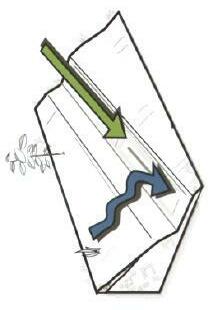
Properly designing trails is both an art and a science. Sustainable trail design reduces environmental impact; increases visitor safety; and is more aesthetically pleasing. The goal is to keep water off the trail. In almost every instance, the sustainable trail needs follow the contours of the land.

NC State Parks strongly recommends that segment sponsors use a professional trail builder to lead the design and construction of trails. Technical assistance in trail design is available from the State Trails Program. Please see the website, https://trails.nc.gov/ for contact information.
The five essential elements of sustainable trails: (adapted from Trail Solutions)
1. Half Rule: The trail needs to move across the landscape so that the slope of the trail is less than half of the slope of the land on either side of the trail. Otherwise, water will run down the trail causing a myriad of issues including erosion and reduced user safety and experience. Surprisingly, this is most commonly an issue in gently sloping terrain.
Trail 8% Grade
This trail meets the Half Rule.
Trail 15% Grade
Sideslope 20% Grade Water will sheet across trail.
This trail breaks the Half Rule.
Sideslope 20% Grade Water will flow down trail.
2. Ten Percent Average Guideline: The average overall grade of the entire trail should be 10% or less to be sustainable.

This applies to most soil types, minimizes erosion, allows design flexibility, and accommodates undulations.

Rise
Grade 10%
Run = 100’
3. Maximum Sustainable Trail Grade: While 10% is the maximum average trail grade, sections of trail can exceed 10% depending on a host of factors including soil type, sideslope, annual rainfall, grade reversals, type of users and the number of users. A trail professional is best equipped to help you decide the maximum grade of your trail.
4. Grade Reversals: This is a location on a trail where the grade changes direction. If the trail is going uphill, there need to be points, about every 20’-50’ where the trail levels out and goes downhill gradually for 10’-50’. It is primarily a way to use gravity to ensure that water gets off the trail surface. It also is a reward for the user, allowing them to use different muscles and resting a little during an extended climb.
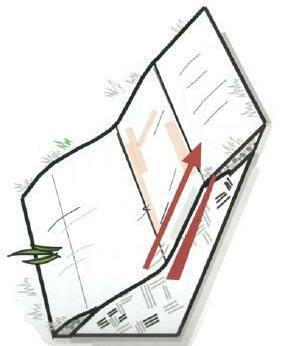
A grade reversal forces water to drain off the trail.
5. Outslope: T he outer (downhill) edge of a trail should be sloped approximately 3-5% downhill. This is yet another construction technique that helps to keep water off the surface of a trail.
Recommended Resources: Trail Solutions: IMBA’s Guide to Building Sweet Singletrack . International Mountain Bicycling Association, Boulder, CO, 2004. Equestrian Design Guidebook for Trails, Trailheads, and Campgrounds . USDA Forest Service, Missoula, MT, 2007 America Trails — www.americatrails.org
All images are from Trail Solutions: IMBA’s Guide to Building Sweet Singletrack Please contact the state trails program if you have any questions about state trails.
Smith Raynor State Trails Planner smith.raynor@ncparks.gov Scott Crocker State Trails Program Manager scott.crocker@ncparks.gov
Scott Crocker State Trails Program Manager scott.crocker@ncparks.gov
The news about the state of the natural world is grim. Over 8,500 species in North America are at risk of extinction. 95% of the United States has been logged, tilled, drained, grazed, paved or otherwise developed 1 . Climate change is upon us. Many people do not feel any connection to the natural world. Habitat fragmentation makes even large plant and animal populations small and isolated from each other, which increases the risk for local extinctions. There is good news. Trails can provide vital biological corridors that enable species to move between habitats. Additionally, with thoughtful management, trails become vital habitats, especially in urban and suburban areas.
Once you have designed and constructed a sustainable trail, you can create quality habitat utilizing the following steps:
1. Remove invasive plant species. Invasive plants truly limit an ecosystem’s ability to function. If you need help determining which plants along the trail are invasive, go to http://nc-ipc.weebly.com/nc-invasive-plants.html. This is the website for the NC Invasive Plant Council and is an excellent resource. You will notice that some of the worst invasives are still being sold in nurseries.
2. Plant keystone species. Research has shown that a few genera of native plants undergird most local ecosystems. These species include native oaks, cherries, willows, goldenrods and asters. To get a specific list for your area, consult the National Wildlife Federation’s Native Plant Finder at https://www.nwf.org/NativePlantFinder.

3. Plant for specialist pollinators. While the Monarch butterfly is probably the best known specialist pollinator, many bees, butterflies and other native insects pollinate only one plant, or plant group. North Carolina Cooperative Extension offers resources for planting for specialist pollinators at https://growingsmallfarms.ces.ncsu.edu/growingsmallfarms-pollinatorconservation/.
4. Plant more plants. Be generous with your plantings and be sure to consider increasing the diversity of your plants, along with the abundance. Think about vertical layers when planning your plantings.
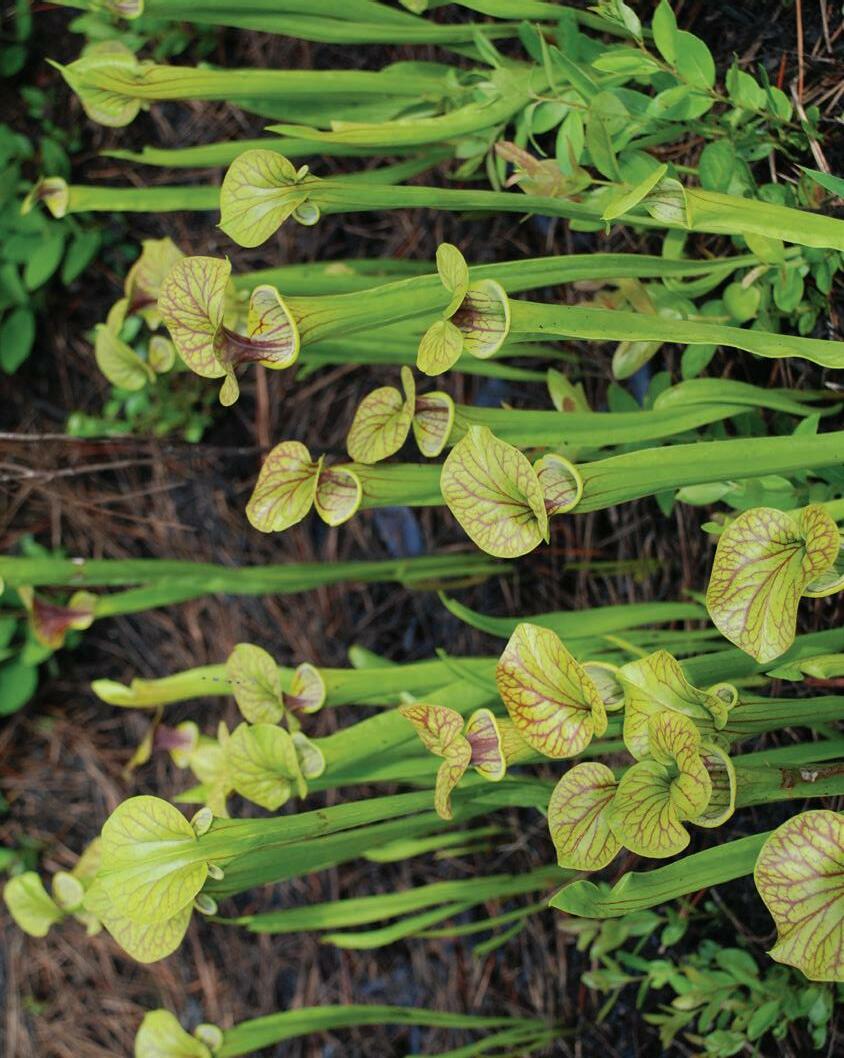
5. Don’t use turfgrass to edge your trail. Use a native groundcover and reduce your maintenance—and make the edge habitat far more inviting for a host of species.
contact the state trails program if you have any questions about state trails.
Smith Raynor State Trails Planner smith.raynor@ncparks.gov Scott Crocker State Trails Program Manager scott.crocker@ncparks.govHerbaceous Plants Garlic mustard ( Alliaria petiolate )
Small carpetgrass ( Arthraxon hispidus )
Giant reed ( Arundo donax )***
Canada Thistle ( Cirsium arvense )
Fig buttercup ( Ficaria verna )
Ground ivy ( Glechoma hederacea )
Giant hogweed ( Heracleum mantegazzianum )*** Cogongrass ( Imperata cylindrica )***
Yellowflag iris ( Iris pseudacorus )
Bicolor/shrub lespedeza ( Lespedeza bicolor )
Chinese lespedeza ( Lespedeza cuneate )
Purple loosestrife ( Lythrum salicaria )***
Japanese stiltgrass ( Microstegium vimineum )
Chinese silvergrass ( Miscanthus sinensis )
Marsh Dewflower ( Murdannia keisak )
Reed canarygrass ( Phalaris arundinacea )
Golden bamboo ( Phyllostachys aurea )
Japanese knotweed ( Reynoutria japonica )
Wineberry ( Rubus phoenicolasius )
Johnson grass ( Sorghum halepense )
Purple Crownvetch ( Securigera varia )
Coltsfoot ( Tussilago farfara )
Trees Tree of Heaven ( Ailanthus altissima )
Mimosa ( Albizia julibrissin )
Princess Tree ( Paulownia tomentosa )
Bradford Pear ( Pyrus calleryana )
Shrubs Leatherleaf Mahonia ( Berberis bealei )
Japanese barberry ( Berberis thunbergii )
Butterfly bush ( Buddleja davidii )
Russian olive ( Elaeagnus angustifolia )
Thorny olive ( Elaeagnus pungens )
Autumn olive ( Elaeagnus umbellate )
Burning bush ( Euonymus alata )
Chinese privet ( Ligustrum sinense )
Sacred bamboo ( Nandina domestica )
Trifoliate orange ( Poncirus trifoliata )***
Multiflora rose ( Rosa multiflora )
Japanese spirea ( Spiraea japonica var. fortune )
Vines
Chocolate vine ( Akebia quinate )***
Porcelain berry ( Ampelopsis brevipedunculata )
Bushkiller ( Cayratia japonica )***
Oriental bittersweet ( Celastrus orbiculatus )
Sweet Autumn Virgin Bower ( Clematis terniflora )
Air potato ( Dioscorea bulbifera )***
Winter creeper ( Euonymus fortunei var. radicans )
English ivy ( Hedera helix )
Japanese honeysuckle ( Lonicera japonica )
Bush honeysuckle ( Lonicera maackii )
Mile-a-minute vine ( Persicaria perfoliate )***
Kudzu ( Pueraria montana )
Japanese wisteria ( Wisteria floribunda )
Chinese wisteria ( Wisteria sinensis )
This list of invasive species was prepared with information from the NC Invasive Plant Council ( http://nc-ipc.weebly.com/ ) and EDDMapS (https://www.eddmaps.org/). These organizations are excellent resources for invasive species.
*** denotes invasive species that are a future threat or have only been found in a few occurrences in the NC mountains. If you find a plant that you suspect is invasive, please report it to NC Dept. of Agriculture by calling 1-800-206-9333 or by email: newpest@ncagr.gov.
Please contact the state trails program if you have any questions about state trails.
Smith Raynor State Trails Planner smith.raynor@ncparks.gov Scott Crocker State Trails Program Manager scott.crocker@ncparks.govNotes
Eligible Applicants: government agencies and non-profit organizations
Eligible Projects: trail construction/maintenance; trail facilities
Match: 25% (cash, in-kind and volunteer hours)
Eligible Applicants: State and local governments
Eligible Projects: outdoor recreation and land acquisition
Match: 50/50
Eligible Applicants: Project applicants may be state and local agencies, tribes, nonprofit organizations, or citizen groups. National Parks and other Federal agencies may apply in partnership with other local organizations.
Eligible Projects: Technical assistance for projects demonstrating tangible conservation and recreational results in the near future. Assistance qualifies for in-kind match for many grants.
Agency/ Organization
Funding from FHWA, administered by NC State Parks
Funding Source
Federal Recreational Trails Program (RTP)
NC State Parks
Land and Water Conservation Fund
Match:
Eligible Applicants: State, local or tribal governments
Eligible Projects: Transportation projects--historically 6% go to bike/ped projects. Applications require cost/benefit analysis. Min project size $1M in rural areas and $5M in urban areas
Match: 20% nonfederal match, but can be less in Tier 2 and 3 counties
National Park Service
NPS Rivers, Trails and Conservation Assistance
U.S. Department of Transportation
Better Utilizing Investment to Leverage Development (BUILD)
Eligible Applicants: local government
Eligible Projects: Land acquisition and construction of parks and recreation projects, including trails Match: 50/50 (cash or land)
NC State Parks/NCSU Recreation Resource Services
Eligible Applicants: government agencies and NPO’s
Eligible Projects: land acquisition, stream restoration, planning, stormwater treatment technology Match: Strongly encouraged
Division of Land and Water Stewardship NC DNCR
Eligible Applicants: local and regional entities
Eligible Projects: Planning, development and implementation of projects that enable and encourage children to walk to school. Sidewalks, shared use paths and intersection improvements are all eligible.
Integrated Mobility Division NC Department of Transportation
Match: 20% local match
Eligible Applicants: Local governments
Eligible Projects: Bicycle and pedestrian and public transportation facilities that appear in a state, regional or locally adopted transportation plan will be included in proposed roadway projects. Your first point of contact should be your Metropolitan or Rural Planning Organization (MPO/RPO)
Match: 20% non-state funds
Eligible Applicants: Varies, but tends to include NPO’s and government agencies Eligible Projects: Varies—several include specific counties and/or healthy outcomes Match: Varies
Eligible Applicants: NPO or governmental agency that serves an area served by Duke Power Eligible Projects: Conservation, access to nature, habitat and forest restoration and conservation Match:
Eligible Applicants: NPOs, governmental, educational and religious organizations serving Black Mountain and the Swannanoa Valley (Owen School District)
Eligible Projects: The Fund’s intent is to support innovative projects and programs in the Swannanoa Valley. Grants of $2,500 to $10,000 are made for charitable purposes, including programmatic needs, equipment and technology, and capital needs. At its discretion, the Black Mountain-Swannanoa Valley Endowment Fund Advisory Board may also consider grant requests for greater or lesser amounts. Generally, requests for continued support for a grant funded in the prior year or for general operating support will be given a lower priority.
Match: Varies
North Department of Transportation
State
Parks and Recreation Trust Fund (PARTF)
Clean Water Management Trust Fund (CWMTF)
Safe Routes to School Program
Strategic Transportation Investments
Private Made in North Carolina Various private foundations
Duke Energy Foundation
Community Foundation of Western North Carolina
Duke Energy
Black Mtn Endowment
Notes
Eligible Applicants: Grants are made to qualified 501(c)(3), governmental, educational, and religious organizations serving McDowell County.
Eligible Projects: The McDowell Endowment provides grants between $2,500$5,000 for charitable purposes. At its discretion, The McDowell Endowment Advisory Board may also consider grant requests for greater or lesser amounts. Requests that exhibit the greatest community benefit will be given the highest consideration.
Match: Varies
Eligible Applicants : Grants are made to qualified 501(c)(3), governmental, educational, and religious organizations serving Rutherford County.
Eligible Projects: Grants of $2,500 to $10,000 will be made to nonprofit organizations and public agencies for charitable purposes, including programmatic and capital needs. Requests that exhibit the greatest community benefit (including requests addressing education; early childhood development; health and wellness; assisting people in need; arts, culture and natural resources; or the environment) will be given the highest consideration.
Match: Varies
Eligible Applicants: Grants are made to nonprofit 501(c)(3) organizations and public agencies serving the following 18 counties: Avery, Buncombe, Burke, Cherokee, Clay, Graham, Haywood, Henderson, Jackson, Macon, Madison, McDowell, Mitchell, Polk, Rutherford, Swain, Transylvania and Yancey and including the Qualla Boundary.
Eligible Projects: Varies — see website for details
Match: Varies
Eligible Applicants: NPOs and governmental agencies Eligible Projects: Grants in this program are not expected to exceed $200,000. Since requests are likely to far exceed funds available, the Foundation will be looking for projects in the following focus areas of Economic Investment and Job Creation, Workforce Preparedness and Education, Agriculture, and Community Vitality.
Agency/ Organization
Community Foundation of Western North Carolina
Community Foundation of Western North Carolina
Source
McDowell County Endowment
Rutherford County Endowment
Community Foundation of North Carolina
Community Foundation of NC
Golden Leaf
Match:
Eligible Applicants: Must be tax-exempt under section 501(c)(3) of the Internal Revenue Code and not classified as a private foundation. Eligible Projects: Projects strengthen communities by investing in affordable housing, revitalization, the arts, and the environment.
Bank of America Charitable Foundation, Inc
Bank of America Charitable Foundation
Match:
Eligible Applicants: charitable, tax-exempt, 501(c)(3) organizations, colleges/universities,
religious entities and government units.
Eligible Projects: The Collaborative Problem-Solving approach is intended to support a limited number of community proposals that use inclusive, collaborative and resourceful processes to authentically engage the community to tackle challenges and create solutions. In particular, we seek to fund efforts that work across sectors (public, private, nonprofit) and/or geographic lines (municipal, county, etc.), are built on existing community assets, use a racial equity lens, and/or bring people together across identity or ideology.
Z Smith Reynolds Foundation
Match:
Please contact the state trails program if you have any questions about state trails.
Smith Raynor State Trails Planner smith.raynor@ncparks.govZ Smith Reynolds
Scott Crocker State Trails Program Manager scott.crocker@ncparks.gov■ Trails are the most desired community amenity that homeowners seek when buying a home.
–Robert Charles Lesser and Co, 2018
■ Homes closer to a regional trail/greenway are valued 5-9% more than similar homes that are farther away (ITRE 2018)
■ One study has shown that for every $1 spent on trail development, $3 are saved in healthcare costs
(American Heart Association, 2011)
■ There is a direct and measurable correlation between how close (up to 2.5 miles) people live to biking and walking infrastructure and how much exercise they get. Those living within 1 mile of a trail get an average of 45 minutes/ week more exercise than they did before a trail was available.
(American Journal of Public Health, 2014)
traveling in increasingly urbanized environments
■ Vegetated trail corridors provide safe passage to wildlife
■ The vegetation protected within a trail corridor traps sediments and slows water in riparian habitats, which increases water quality
■ Trails help air quality both by reducing motor vehicle use and by maintaining trees which absorb pollutants
■ Provide habitat for native species
Provide recreational opportunities
■ Hiking and walking are consistently ranked as the #1 outdoor activity across age groups (Adventure Travel Trade
Association, 2017)
■ Retail shops, restaurants, accommodations and other industries in local and regional economies can experience notable economic benefits when in proximity to a shared use path (ITRE, 2018)
■ The American Tobacco Trail (22+ mile trail in Triangle area) contributes $6.1M to the local economy annually; supports 78 jobs and generates $2.2M annually in labor income (ITRE, 2018)
■ Contribute to a community’s identity
■ The Town of Elkin is a prime example. Since promoting the MST, they have seen new trail-based businesses rejuvenate an economy that was formerly dependent on the textile industry
■ Provide alternative transportation opportunities
■ Reduces motor vehicle emissions and the amount of traffic on roads as commuters take advantage of alternative ways to get to work and school.
Please contact the state trails program if you have any questions about state trails. Scott Crocker State Trails Program Manager scott.crocker@ncparks.gov
Smith Raynor State Trails Planner smith.raynor@ncparks.gov